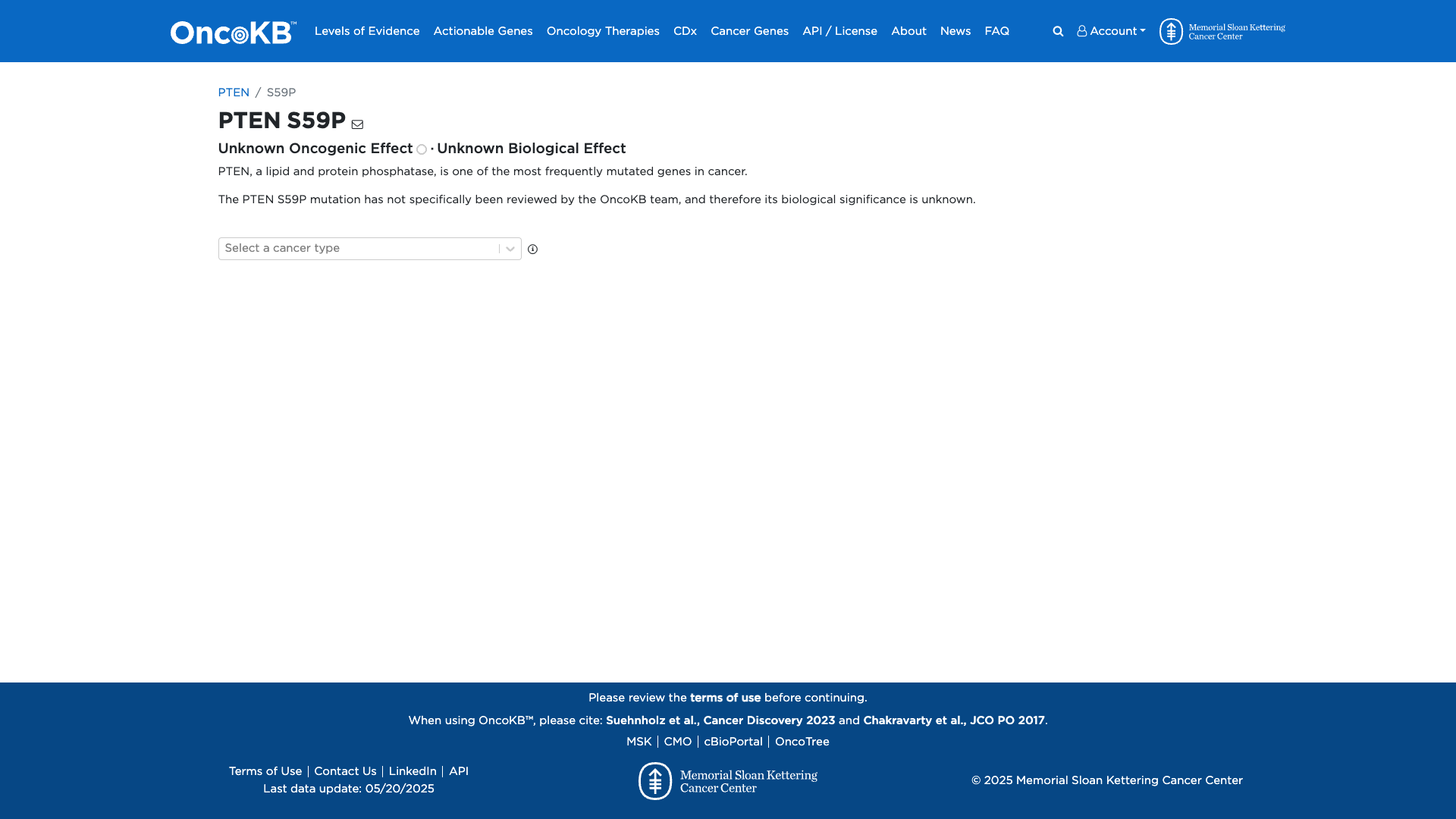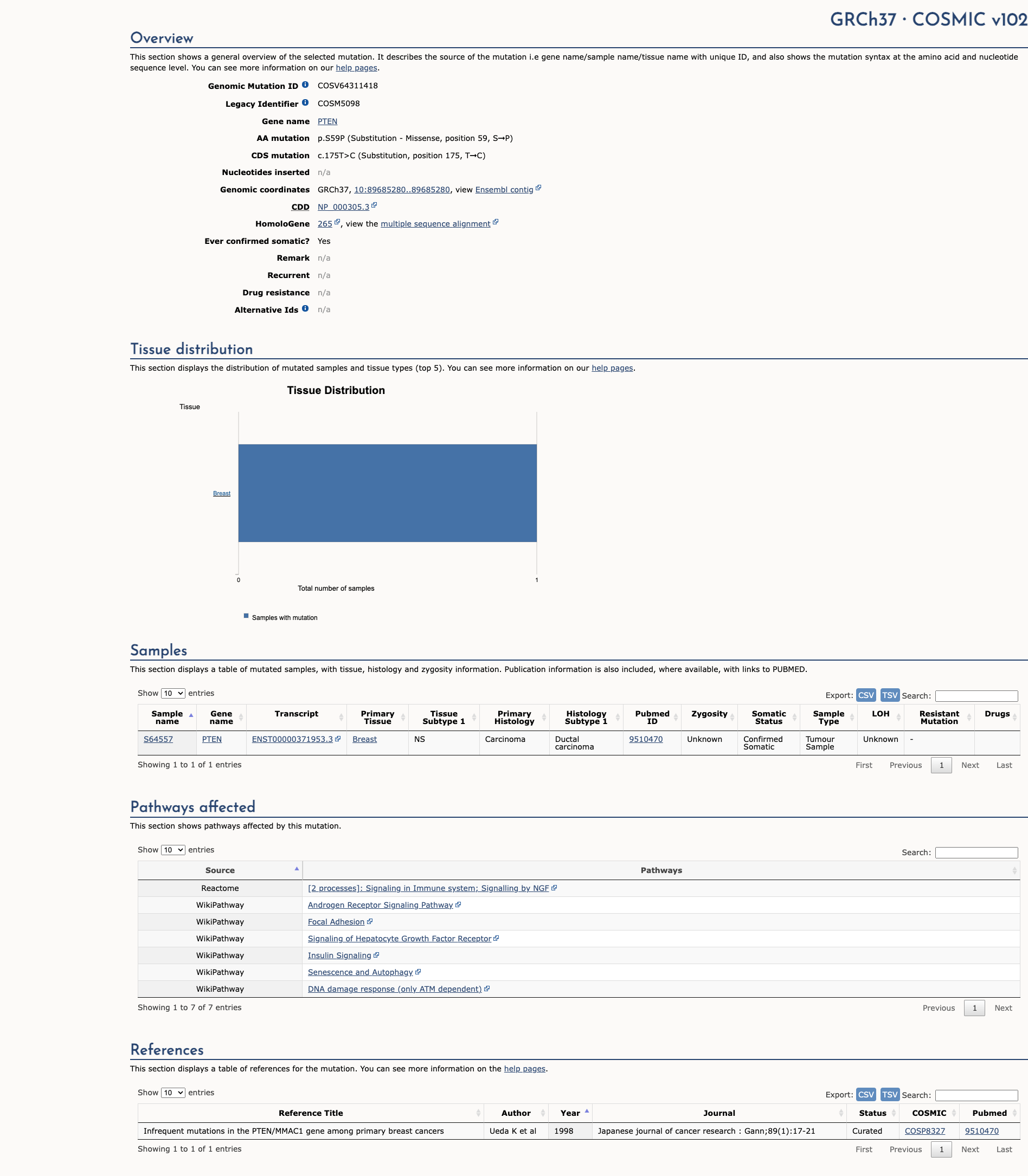PTEN c.175T>C, p.Ser59Pro
NM_000314.8:c.175T>C
COSMIC ID: COSM5098
Likely Pathogenic
This missense variant in PTEN (S59P) has moderate functional evidence of damaging effect (PS3_Moderate) and two supporting criteria (PM2 and PP3) but lacks sufficient additional evidence for a Likely Pathogenic classification under ACMG/VCEP rules. It is therefore classified as a Variant of Uncertain Significance.
ACMG/AMP Criteria Applied
PS3
PM2
PP3
Genetic Information
Gene & Transcript Details
Gene
PTEN
Transcript
NM_000314.8
MANE Select
Total Exons
9
Strand
Forward (+)
Reference Sequence
NC_000010.10
Alternative Transcripts
| ID | Status | Details |
|---|---|---|
| NM_000314.7 | RefSeq Select | 9 exons | Forward |
| NM_000314.5 | Alternative | 9 exons | Forward |
| NM_000314.4 | Alternative | 9 exons | Forward |
| NM_000314.3 | Alternative | 9 exons | Forward |
| NM_000314.6 | Alternative | 9 exons | Forward |
Variant Details
HGVS Notation
NM_000314.8:c.175T>C
Protein Change
S59P
Location
Exon 3
(Exon 3 of 9)
5'Exon Structure (9 total)3'
Functional Consequence
Loss of Function
Related Variants
No evidence of other pathogenic variants at position 59 in gene PTEN
Alternate Identifiers
COSM5098
Variant interpretation based on transcript NM_000314.8
Genome Browser
Loading genome browser...
HGVS InputNM_000314:c.175T>C
Active Tracks
ConservationRefSeqClinVargnomAD
Navigation tips: Use mouse to drag and zoom. Click on features for details.
Clinical Data
Population Frequency
Global Frequency
0.0 in 100,000
Extremely Rare
Global: 0.0%
0%
0.05%
0.1%
1%
5%
10%+
ACMG Criteria Applied
PM2
This variant is not present in gnomAD (PM2 criteria applies).
Classification
Uncertain Significance (VUS)
Based on 1 submitter review in ClinVar
Submitter Breakdown
1 VUS
Pathogenic
Likely Path.
VUS
Likely Benign
Benign
Publications (0)
No publication details.
Clinical Statement
This variant has been reported in ClinVar as Uncertain significance (1 clinical laboratories).
Functional Impact
Functional Domain
Hotspot Status
Not a hotspot
Domain Summary
This variant is not located in a mutational hotspot or critical domain (0 mutations).
Related Variants in This Domain
No evidence of other pathogenic variants at position 59 in gene PTEN
Functional Summary
The PTEN S59P variant results in reduced phosphatase activity in a yeast assay, indicating a loss of PTEN protein function.
Database Previews
OncoKB

JAX-CKB

Click on previews to view full database entries. External databases may require institutional access.
Computational Analysis
Pathogenicity Predictions
REVEL Score
0.898
0.898
Likely Benign0.0
Uncertain (Low)0.2
Uncertain (Med)0.5
Likely Pathogenic0.75
REVEL scores ≥ 0.75 are strong evidence (PP3)
Predictor Consensus
Pathogenic
PP3 Applied
Yes
Additional Predictors
Pathogenic:
sift: Dpolyphen_prediction: probably_damagingmutationtaster: Dfathmm: Dprovean: Dmetasvm: Dmetalr: Dprimateai: Ddeogen2: D
Benign:
CADD: 5.32
Neutral: Show all
VCEP Guidelines
Applied ACMG/AMP Criteria (VCEP Specific) VCEP Guidelines
PVS1
PVS1 (Not Applied) Strength Modified
According to VCEP guidelines, the rule for PVS1 is: "Very Strong Use PTEN PVS1 decision tree. Modification Type: Disease-specific." The evidence for this variant shows it is a missense change (S59P), not a predicted null (nonsense/frameshift) variant. Therefore, this criterion is not applied.
PS1
PS1 (Not Applied) Strength Modified
According to VCEP guidelines, the rule for PS1 is: "Strong Same amino acid change as a previously established pathogenic variant regardless of nucleotide change OR different variant at same nucleotide position as a pathogenic splicing variant..." The evidence for this variant shows no previously established pathogenic S59P change. Therefore, this criterion is not applied.
PS2
PS2 (Not Applied) Strength Modified
According to VCEP guidelines, the rule for PS2 is: "Very Strong Two proven OR four assumed OR one proven + two assumed de novo observations..." There are no de novo data for this variant. Therefore, this criterion is not applied.
PS3
PS3 (Moderate) Strength Modified
According to PTEN pre-processing, the finding for PS3_Moderate is: "Phosphatase activity score -3.5610 < -1.11 per Mighell et al. 2018." The evidence for this variant shows reduced phosphatase activity in a yeast assay (score -3.5610). Therefore, this criterion is applied at Moderate strength because the functional data meet the PTEN-specific PS3_moderate threshold.
PS4
PS4 (Not Applied) Strength Modified
According to VCEP guidelines, the rule for PS4 is: "Very Strong Probands with specificity score ≥16; Strong specificity score 4–15.5; Moderate 2–3.5; Supporting 1–1.5." There are no case or proband data. Therefore, this criterion is not applied.
PM1
PM1 (Not Applied) Strength Modified
According to VCEP guidelines, the rule for PM1 is: "Moderate Located in a mutational hot spot and/or critical and well-established functional domain (residues 90–94, 123–130, 166–168)." The S59P change is outside these motifs. Therefore, this criterion is not applied.
PM2
PM2 (Supporting) Strength Modified
According to VCEP guidelines, the rule for PM2 is: "Supporting Absent in population Databases present at <0.00001 allele frequency in gnomAD..." The evidence for this variant shows it is absent from gnomAD and other databases. Therefore, this criterion is applied at Supporting strength.
PM3
PM3 (Not Applied) Strength Modified
According to standard ACMG guidelines, the rule for PM3 is: "Moderate For recessive disorders, detected in trans with a pathogenic variant." PTEN-associated conditions are autosomal dominant and no trans data exist. Therefore, this criterion is not applied.
PM4
PM4 (Not Applied) Strength Modified
According to standard ACMG guidelines, the rule for PM4 is: "Moderate Protein length changes due to in-frame deletions/insertions or stop-loss." The variant is a missense change, not an in-frame indel. Therefore, this criterion is not applied.
PM5
PM5 (Not Applied) Strength Modified
According to VCEP guidelines, the rule for PM5 is: "Moderate Missense change at a residue where a different pathogenic missense change has been seen." No other pathogenic missense variant at residue 59 is reported. Therefore, this criterion is not applied.
PM6
PM6 (Not Applied) Strength Modified
According to VCEP guidelines, the rule for PM6 is: "Moderate Assumed de novo, without confirmation of paternity/maternity." There are no de novo data. Therefore, this criterion is not applied.
PP1
PP1 (Not Applied) Strength Modified
According to VCEP guidelines, the rule for PP1 is: "Supporting Co-segregation with disease in multiple affected family members (3–4 meioses)." There are no segregation data. Therefore, this criterion is not applied.
PP2
PP2 (Not Applied) Strength Modified
According to standard ACMG guidelines, the rule for PP2 is: "Supporting Missense variant in gene with low rate of benign missense variation and where missense variants are a common mechanism of disease." Insufficient evidence of low benign missense rate in PTEN to confidently apply. Therefore, this criterion is not applied.
PP3
PP3 (Supporting)
According to VCEP guidelines, the rule for PP3 is: "Supporting Multiple lines of computational evidence support a deleterious effect on the gene or gene product; REVEL score >0.7." The variant has REVEL 0.90 and concordant in silico predictions. Therefore, this criterion is applied at Supporting strength.
PP4
PP4 (Not Applied) Strength Modified
According to standard ACMG guidelines, the rule for PP4 is: "Supporting Patient's phenotype or family history is highly specific for a disease with a single genetic etiology." No phenotype data are provided. Therefore, this criterion is not applied.
PP5
PP5 (Not Applied) Strength Modified
According to standard ACMG guidelines, the rule for PP5 is: "Supporting Reputable source classifies variant as pathogenic." ClinVar reports this variant as VUS. Therefore, this criterion is not applied.
BA1
BA1 (Not Applied) Strength Modified
According to VCEP guidelines, the rule for BA1 is: "Stand Alone gnomAD Filtering allele frequency >0.00056." The variant is absent from population databases. Therefore, this criterion is not applied.
BS1
BS1 (Not Applied) Strength Modified
According to VCEP guidelines, the rule for BS1 is: "Strong Allele frequency 0.000043–0.00056." The variant is absent. Therefore, this criterion is not applied.
BS2
BS2 (Not Applied) Strength Modified
According to VCEP guidelines, the rule for BS2 is: "Strong Observed homozygous in unaffected individual." No homozygous observations are reported. Therefore, this criterion is not applied.
BS3
BS3 (Not Applied) Strength Modified
According to VCEP guidelines, the rule for BS3 is: "Strong Well-established functional studies show no damaging effect." Functional data show a damaging effect. Therefore, this criterion is not applied.
BS4
BS4 (Not Applied) Strength Modified
According to VCEP guidelines, the rule for BS4 is: "Strong Lack of segregation in affected members of two or more families." No segregation data are available. Therefore, this criterion is not applied.
BP1
BP1 (Not Applied) Strength Modified
According to standard ACMG guidelines, the rule for BP1 is: "Supporting Missense variant in gene where truncating variants are the only known mechanism." PTEN has known pathogenic missense variants. Therefore, this criterion is not applied.
BP2
BP2 (Not Applied) Strength Modified
According to VCEP guidelines, the rule for BP2 is: "Supporting Observed in trans with a pathogenic PTEN variant..." There is no evidence of cis/trans observations. Therefore, this criterion is not applied.
BP3
BP3 (Not Applied) Strength Modified
According to standard ACMG guidelines, the rule for BP3 is: "Supporting In-frame deletions/insertions in repetitive regions without a known function." The variant is a missense change. Therefore, this criterion is not applied.
BP4
BP4 (Not Applied) Strength Modified
According to VCEP guidelines, the rule for BP4 is: "Supporting Multiple lines of computational evidence suggest no impact; REVEL <0.5." The variant has REVEL 0.90 predicting deleterious effect. Therefore, this criterion is not applied.
BP5
BP5 (Not Applied) Strength Modified
According to standard ACMG guidelines, the rule for BP5 is: "Supporting Variant found in a case with an alternate molecular basis for disease." No alternate molecular basis is reported. Therefore, this criterion is not applied.
BP6
BP6 (Not Applied) Strength Modified
According to standard ACMG guidelines, the rule for BP6 is: "Supporting Reputable source classifies variant as benign." No such benign classification exists. Therefore, this criterion is not applied.
BP7
BP7 (Not Applied) Strength Modified
According to standard ACMG guidelines, the rule for BP7 is: "Supporting Synonymous variant with no splicing impact." The variant is missense. Therefore, this criterion is not applied.

